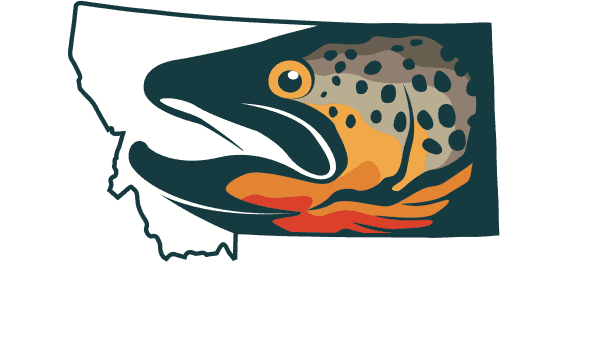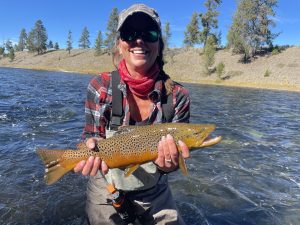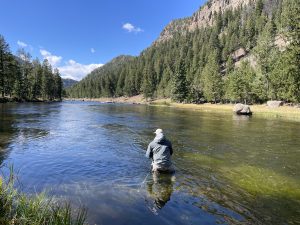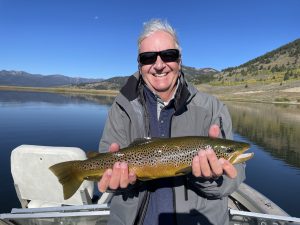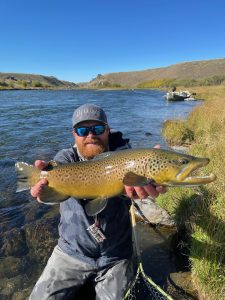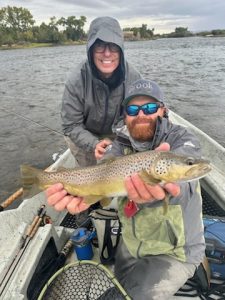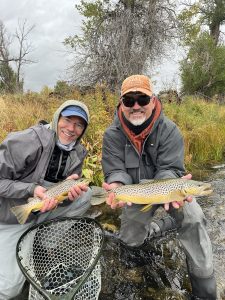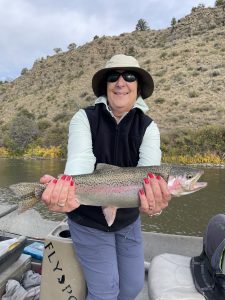THE RUN HAS BEGUN!
If you’re in the Yellowstone National Park or the Madison Valley, all you have to do is look up, and you can see the trees are in full fall plumage. They make quite a sight against the backdrop of green fir and pine trees. All of this has some folks lamenting the end of summer, but not fishermen.
“Bad” weather is good news for anyone coming to fish in Montana or Yellowstone National Park. It is no coincidence that a run of rawer, overcast days made for some of the best fishing days yet this fall. It has also helped that water temps have dropped to the point that the restrictions that stopped fishing at 2 p.m. on the Lower Madison have been lifted.
On the overcast days, we’ve started to see blue-wing olive hatches and fish rising to the surface. Dusk days are also prime for streamer fishing, and we’re excited to say the fish have been more than willing to chase the big flies. Right now, tried and true patterns like the white/olive Barely Lethal and the olive Peanut Envy have been lights out. Really, anything green seems to attract the attention of the fish.
Right now, before the run is in full swing, can be a great time to come because fish stack at the mouths of tributaries or in the first few miles in the rivers flowing out of the lakes. More concentrated fish means they are easier to find, and you can have a banner day in a short stretch of water.
Right now, we’re targeting the stretches of the Madison River from Warm Springs to the Missouri or the Gallatin River from Manhattan to the headwaters. Both have seen an influx of large, aggressive fish that our clients have been targeting and landing regularly this past week, and by the looks of it, things are only getting better.
RISING RATES
Due to increases in our expenditures for boat shuttles, client lunches, guide permitting fees, and commercial use charges for outfitters, we will be raising our rates for 2025 as of November 1, 2024. Any trips booked before that date with a 50% deposit will secure the lower 2024 rates currently on our website.
Not only is booking a great way to save, it also allows you to secure the guide of your choice. And once you know when you are coming you can also book lodging, which is also cheaper and more plentiful the farther out you book it.
MOVEMENT ON THE MADISON
Cooler temps and lower light triggered the fish in the Ennis, Quake, and Hegben lakes, getting the browns moving into the Madison River. We’re not quite there, but the peak spawning run is coming soon.
One of the keys to being successful on the Madison this time of year is to get out early. Bring your headlamp because we like to hit the water at first light so that we can be the first ones on the river. Batting lead-off means hitting each hole before everyone else and having the best and maybe only chance to catch the fish hunkered down there.
And it’s not just the one fish that is usually inhabiting these deeper pools and runs. Oftentimes, big fish will pair up in these spots, and if you’re the early bird, you can pull multiple pigs out of one pocket.
Overnight, the fish will move, and the river system will reset. So remember where you caught those fish the day before because chances are a new group has moved into the hole, and you get a whole new chance to fish it again.
FIREHOLE OPEN ALL-DAY
Another sign of cooler air and water temps is that Yellowstone National Park has lifted the partial fishing restrictions that closed the Firehole River after 2 p.m. Now the river is fishable from sunrise to sunset.
Close to the road and manageable to wade, the Firehole is a great option for anyone looking for a relaxing day of fishing. Still, don’t let the heat coming off the thermal features fool you – dressing for cold and inclement weather is still a must and so is bringing a box full of soft hackles, white Miller’s caddis, and small blue wing olives.
SEASONAL WEATHER TIPS
While we consider snow, rain, clouds, and cooler temps good for fishing, it can be bad for other things. First off, driving. The roads around where we fish, especially those in canyons and over mountain passes, can turn sketchy pretty quickly.
Chances are you’re coming from somewhere where it’s still warm enough that this may not be front of mind when you’re planning your trip. So, if you’re renting a car, choose wisely when you’re picking out your model and opt for something with four-wheel or all-wheel drive. Anything with rear-wheel drive is a definite pass, and if you can avoid anything with low ground clearance, you might save yourself some headaches, too.
Once you get to where you are going to fish, make sure you are wearing comfortable clothing, and for this time of year, that means layers. It’s not unheard of to have temps in the thirties when we hit the water in the morning, but by early afternoon, it’s in the eighties with the Big Sky sun beating down. In between, it can rain, snow, hail, or be windy, so come prepared with an array of versatile clothing options (our checklist has some great suggestions) that allow you to enjoy the weather, whatever it may be.
Probably the biggest question we get this time of year is: how do I keep my hands warm? It’s a fair ask. A lot of people bring fingerless gloves, thinking they’ll be the answer. They can definitely help, but when you’re stripping a wet line or handling a wet rod, your fingers will turn cold pretty quickly.
The best solution we’ve come across is latex gloves like the ones you can buy somewhere like Costco or Harbor Freight. Not only do they keep your hands dry, but they’re also thin enough that you can feel your line through them. Another plus is that the latex wicks moisture and retains your body heat so your hands stay warm. They’re also thin enough that you can pull a pair of insulated gloves over them when you’re not fishing.
Just remember, just like your hands, latex gloves should be wet before they touch any fish.
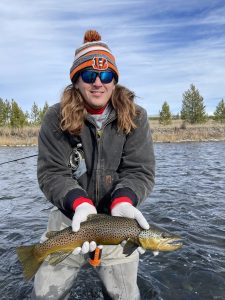
GO TIME ON THE GALLATIN
Fish aren’t just leaving the lakes to spawn; they’re also exiting larger river systems such as the Missouri for tributaries that feed into them, like the Gallatin River. Because of this, the lower Gallatin, from Manhattan to Three Forks, where it empties into the Missouri, can be home to some huge browns this time of year.
The other day, we took out a group of eight anglers, and they found plenty of browns willing to eat dead drifted streamers, especially Mayer’s Mini Leech pattern in black.
Nymphs were also doing the job with the Blow Torch, Frenchie, and Rainbow Warrior designs by the most successful.
Follow us on Instagram and Facebook for more current and up-to-date information.
